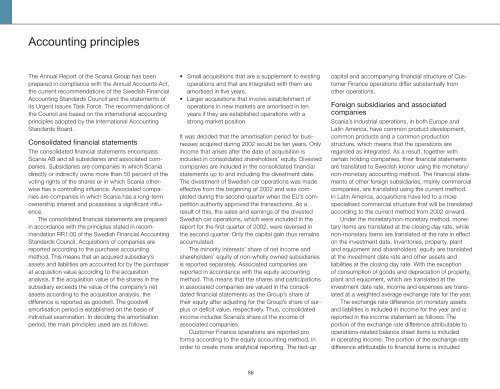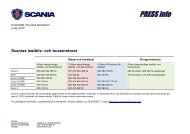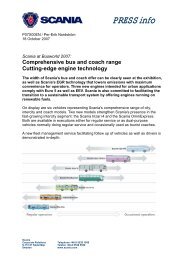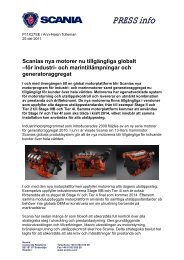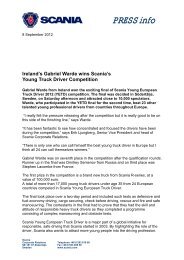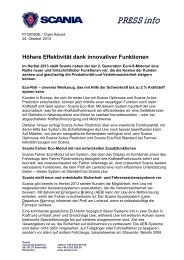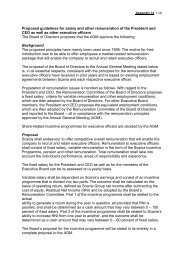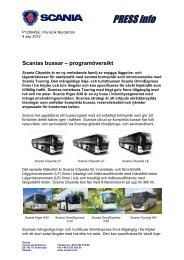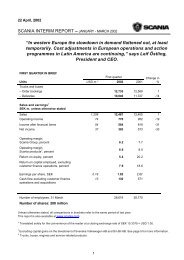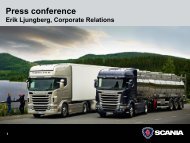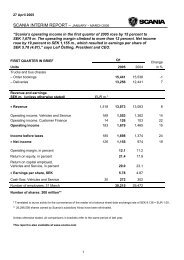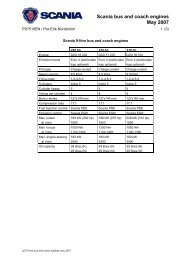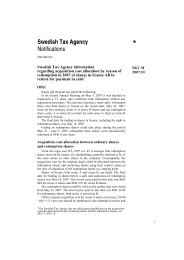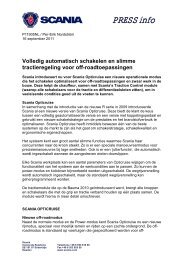Scania annual report 2002
Scania annual report 2002
Scania annual report 2002
You also want an ePaper? Increase the reach of your titles
YUMPU automatically turns print PDFs into web optimized ePapers that Google loves.
Accounting principles<br />
The Annual Report of the <strong>Scania</strong> Group has been<br />
prepared in compliance with the Annual Accounts Act,<br />
the current recommendations of the Swedish Financial<br />
Accounting Standards Council and the statements of<br />
its Urgent Issues Task Force. The recommendations of<br />
the Council are based on the international accounting<br />
principles adopted by the International Accounting<br />
Standards Board.<br />
Consolidated financial statements<br />
The consolidated financial statements encompass<br />
<strong>Scania</strong> AB and all subsidiaries and associated companies.<br />
Subsidiaries are companies in which <strong>Scania</strong><br />
directly or indirectly owns more than 50 percent of the<br />
voting rights of the shares or in which <strong>Scania</strong> otherwise<br />
has a controlling influence. Associated companies<br />
are companies in which <strong>Scania</strong> has a long-term<br />
ownership interest and possesses a significant influence.<br />
The consolidated financial statements are prepared<br />
in accordance with the principles stated in recommendation<br />
RR1:00 of the Swedish Financial Accounting<br />
Standards Council. Acquisitions of companies are<br />
<strong>report</strong>ed according to the purchase accounting<br />
method. This means that an acquired subsidiary’s<br />
assets and liabilities are accounted for by the purchaser<br />
at acquisition value according to the acquisition<br />
analysis. If the acquisition value of the shares in the<br />
subsidiary exceeds the value of the company’s net<br />
assets according to the acquisition analysis, the<br />
difference is <strong>report</strong>ed as goodwill. The goodwill<br />
amortisation period is established on the basis of<br />
individual examination. In deciding the amortisation<br />
period, the main principles used are as follows:<br />
• Small acquisitions that are a supplement to existing<br />
operations and that are integrated with them are<br />
amortised in five years.<br />
• Larger acquisitions that involve establishment of<br />
operations in new markets are amortised in ten<br />
years if they are established operations with a<br />
strong market position.<br />
It was decided that the amortisation period for businesses<br />
acquired during <strong>2002</strong> would be ten years. Only<br />
income that arises after the date of acquisition is<br />
included in consolidated shareholders’ equity. Divested<br />
companies are included in the consolidated financial<br />
statements up to and including the divestment date.<br />
The divestment of Swedish car operations was made<br />
effective from the beginning of <strong>2002</strong> and was completed<br />
during the second quarter when the EU’s competition<br />
authority approved the transactions. As a<br />
result of this, the sales and earnings of the divested<br />
Swedish car operations, which were included in the<br />
<strong>report</strong> for the first quarter of <strong>2002</strong>, were reversed in<br />
the second quarter. Only the capital gain thus remains<br />
accumulated.<br />
The minority interests’ share of net income and<br />
shareholders’ equity of non-wholly owned subsidiaries<br />
is <strong>report</strong>ed separately. Associated companies are<br />
<strong>report</strong>ed in accordance with the equity accounting<br />
method. This means that the shares and participations<br />
in associated companies are valued in the consolidated<br />
financial statements as the Group’s share of<br />
their equity after adjusting for the Group’s share of surplus<br />
or deficit value, respectively. Thus, consolidated<br />
income includes <strong>Scania</strong>’s share of the income of<br />
associated companies.<br />
Customer Finance operations are <strong>report</strong>ed pro<br />
forma according to the equity accounting method, in<br />
order to create more analytical <strong>report</strong>ing. The tied-up<br />
capital and accompanying financial structure of Customer<br />
Finance operations differ substantially from<br />
other operations.<br />
Foreign subsidiaries and associated<br />
companies<br />
<strong>Scania</strong>’s industrial operations, in both Europe and<br />
Latin America, have common product development,<br />
common products and a common production<br />
structure, which means that the operations are<br />
regarded as integrated. As a result, together with<br />
certain holding companies, their financial statements<br />
are translated to Swedish kronor using the monetary/<br />
non-monetary accounting method. The financial statements<br />
of other foreign subsidiaries, mainly commercial<br />
companies, are translated using the current method.<br />
In Latin America, acquisitions have led to a more<br />
specialised commercial structure that will be translated<br />
according to the current method from <strong>2002</strong> onward.<br />
Under the monetary/non-monetary method, monetary<br />
items are translated at the closing day rate, while<br />
non-monetary items are translated at the rate in effect<br />
on the investment date. Inventories, property, plant<br />
and equipment and shareholders’ equity are translated<br />
at the investment date rate and other assets and<br />
liabilities at the closing day rate. With the exception<br />
of consumption of goods and depreciation of property,<br />
plant and equipment, which are translated at the<br />
investment date rate, income and expenses are translated<br />
at a weighted average exchange rate for the year.<br />
The exchange rate difference on monetary assets<br />
and liabilities is included in income for the year and is<br />
<strong>report</strong>ed in the income statement as follows: The<br />
portion of the exchange rate difference attributable to<br />
operations-related balance sheet items is included<br />
in operating income. The portion of the exchange rate<br />
difference attributable to financial items is included<br />
56


